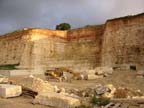
If you were to ask a layman about Italy's stone industry, they would likely tell you about Michelangelo's white marble quarries in Carrara or the rich stoneworking tradition in Verona. However, off the mainland, the island of Sicily has a deep culture in natural stone. Its city centers and churches are adorned with locally quarried marble, limestone and lava stone, which helped achieve the Baroque architecture that typifies many prominent structures. That culture remains alive today, as there are several areas within Sicily that can accurately be classified as “stoneworking regions,†and they are equipped with state-of-the-art technology. An in-depth tour of Sicily reveals a diverse array of stone production plants, and each region has its own tradition in natural stone.

Trapani
In the province of Trapani, on Sicily's western coast, beautiful rock formations grace the shoreline. They also contain the island's best-known stone export -- Perlato di Sicilia marble. Although Perlato di Sicilia is the general term by which it is internationally known,there are actually many different classifications and varieties of this marble. It is quite similar to the broad reference to “White Carrara marble,†which also has many classifications within the general category.
The color is essentially beige, and the variation among classifications depends on the amount and pattern of the veining. The Perlatino varieties have a tighter, more compact pattern on the surface than Perlato. Additionally, the quarries yield some colored varieties, including tones of red and green.
Most of the marble quarries are actually in the town of Custonaci, within the Trapani Province but just outside the city center. Custonaci has a population of 5,000 people, the bulk of which work in the quarries or stoneworking operations. In all, the region boasts 130 active quarries and 3,500 people working in the industry.
Although the marble of Trapani has been quarried on an industrial scale for around 90 years, it has been used for centuries. Today, Custonaci/Trapani is responsible for 85% of Sicily's stone production and approximately 12% of Italy's production.
Recently, there has been a reawakening of interest in some of the most historic materials of the region, such as the highly coveted Libeccio, which was used for the Sistine Chapel and other prestigious projects. It also played a significant role in the Baroque architecture that was prevalent during the 17th and 18th centuries. This material will be used for a major project in Dubai, where it was specified for the top 600 villas of one of the region's most upscale hotels.
Almost all of the quarries are located high above sea level -- 1,500 feet or more -- overlooking the city of Trapani as well as the Mediterranean Sea. As one producer noted, “The common ground to all quarries is that the view is so pretty.â€
And the quarrying industry still has room for growth. The region allows the development of new quarries, but there are important environmental controls, explained Alberto Santoro, the mayor of Custonaci and also the sales manager for Santoro Marmi, a local producer.
Catania
When Mount Etna erupted in 1669, it unwittingly gave birth to an entire stoneworking tradition on Sicily's east coast. Lava stone -- technically known as basalt -- can be found throughout the state of Catania, as outcroppings in farms; as boulders outside of the Catania city center; and in finished form throughout the city. It is used for paving and curbing throughout the city and beyond, and is also used for carved architectural work.Throughout the years, the lava stone of Catania has maintained the same basic appearance, even as quarrying methods have advanced to the point that explosives are no longer necessary.
Large boulders of lava stone are taken from the earth and trimmed to size, and the process for fabricating the material can vary a great deal, depending on the final product. Adjacent to many quarry sites, venerable stonecrafters can be found splitting and chiseling stone by hand. At the same time, modern stoneworking machinery from Italy is also used for tile production as well as fabrication of cut-to-size work.
Ragusa
The varieties of limestone that are found in the province of Ragusa have considerable hardness -- similar to that of French limestone -- and can be used for a range of indoor and outdoor applications. Ragusa's Baroque architecture has relied on this stone to form entire neighborhoods, and it can be found throughout the historical towns of Modica and Comiso. As such, it continues to play a role in restoringand updating historic structures, including the San Giorgia Duomo in Ragusa, which is currently undergoing restoration.
In new construction, the limestone of Ragusa is being fabricated for a complete spectrum of architectural pieces, including split-faced cladding, columns, memorials, staircases, balustrades, benches and other elements. The process for creating these items is a blend of time-honored craftsmanship and modern technology -- such as turning lathes and multi-axis sawing equipment. Master stonecarvers can also be found at some shops, plying their trade in one of the most artful forms of stone fabrication.
Palermo
In the 1600s, financial prosperity led the people of Palermo to begin using locally quarried Billiemi marble for their own purposes, rather than strictly exporting material off the island. The stone, which is gray with subtle veining, is not only aesthetically pleasing, but it also serves an interesting practical purpose. Since the material does not absorb humidity, it is very suitable to use in Palermo's warm climate -- which can turn oppressively hot during the summer.Billiemi marble is considered to be the original paving stone of Palermo, and it has contributed to both Norman and Baroque styles of architecture within the city. It continues to be used today in modern applications, such as the Piazza Della Memoria, which was built to honor those slain in the battle against the Mafia.
Palermo's modern architecture is also developing as a consumer of foreign stones. Its City Courthouse, for example, was built with Brazilian granite in a modern ventilated cladding system using large 5- x 3-foot pieces of granite.